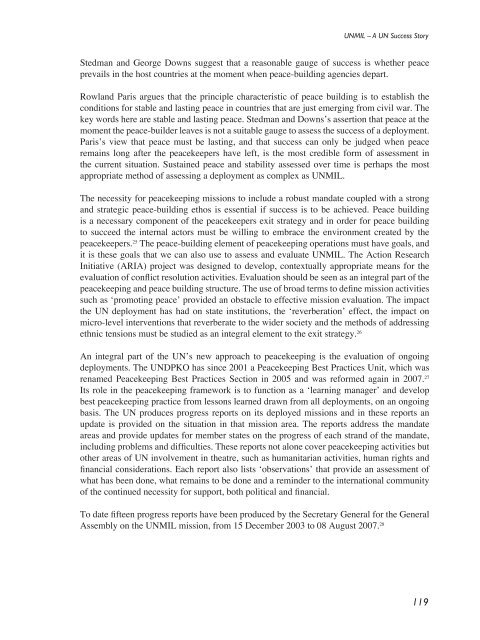Defence Forces Review 2008
Defence Forces Review 2008
Defence Forces Review 2008
You also want an ePaper? Increase the reach of your titles
YUMPU automatically turns print PDFs into web optimized ePapers that Google loves.
UNMIL – A UN Success Story<br />
Stedman and George Downs suggest that a reasonable gauge of success is whether peace<br />
prevails in the host countries at the moment when peace-building agencies depart.<br />
Rowland Paris argues that the principle characteristic of peace building is to establish the<br />
conditions for stable and lasting peace in countries that are just emerging from civil war. The<br />
key words here are stable and lasting peace. Stedman and Downs’s assertion that peace at the<br />
moment the peace-builder leaves is not a suitable gauge to assess the success of a deployment.<br />
Paris’s view that peace must be lasting, and that success can only be judged when peace<br />
remains long after the peacekeepers have left, is the most credible form of assessment in<br />
the current situation. Sustained peace and stability assessed over time is perhaps the most<br />
appropriate method of assessing a deployment as complex as UNMIL.<br />
The necessity for peacekeeping missions to include a robust mandate coupled with a strong<br />
and strategic peace-building ethos is essential if success is to be achieved. Peace building<br />
is a necessary component of the peacekeepers exit strategy and in order for peace building<br />
to succeed the internal actors must be willing to embrace the environment created by the<br />
peacekeepers. 25 The peace-building element of peacekeeping operations must have goals, and<br />
it is these goals that we can also use to assess and evaluate UNMIL. The Action Research<br />
Initiative (ARIA) project was designed to develop, contextually appropriate means for the<br />
evaluation of conflict resolution activities. Evaluation should be seen as an integral part of the<br />
peacekeeping and peace building structure. The use of broad terms to define mission activities<br />
such as ‘promoting peace’ provided an obstacle to effective mission evaluation. The impact<br />
the UN deployment has had on state institutions, the ‘reverberation’ effect, the impact on<br />
micro-level interventions that reverberate to the wider society and the methods of addressing<br />
ethnic tensions must be studied as an integral element to the exit strategy. 26<br />
An integral part of the UN’s new approach to peacekeeping is the evaluation of ongoing<br />
deployments. The UNDPKO has since 2001 a Peacekeeping Best Practices Unit, which was<br />
renamed Peacekeeping Best Practices Section in 2005 and was reformed again in 2007. 27<br />
Its role in the peacekeeping framework is to function as a ‘learning manager’ and develop<br />
best peacekeeping practice from lessons learned drawn from all deployments, on an ongoing<br />
basis. The UN produces progress reports on its deployed missions and in these reports an<br />
update is provided on the situation in that mission area. The reports address the mandate<br />
areas and provide updates for member states on the progress of each strand of the mandate,<br />
including problems and difficulties. These reports not alone cover peacekeeping activities but<br />
other areas of UN involvement in theatre, such as humanitarian activities, human rights and<br />
financial considerations. Each report also lists ‘observations’ that provide an assessment of<br />
what has been done, what remains to be done and a reminder to the international community<br />
of the continued necessity for support, both political and financial.<br />
To date fifteen progress reports have been produced by the Secretary General for the General<br />
Assembly on the UNMIL mission, from 15 December 2003 to 08 August 2007. 28<br />
119
















